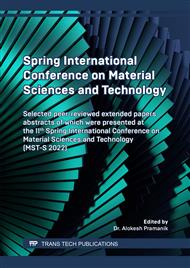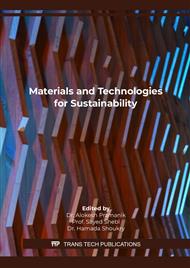[1]
A. K. Mukhopadhyay, Microstructure and properties of high strength aluminium alloys for structural applications, T. Indian I. Metals. 62 (2009) 113-122.
DOI: 10.1007/s12666-009-0015-z
Google Scholar
[2]
N. M. Han, X. M. Zhang, S. D. Liu, et al, Effect of solution treatment on the strength and fracture toughness of aluminum alloy 7050, J. Alloys Compd. 509 (2011) 4138-4145.
DOI: 10.1016/j.jallcom.2011.01.005
Google Scholar
[3]
H. T. Jeong, W. J. Kim, Comparison of hot deformation behavior characteristics between as-cast and extruded Al-Zn-Mg-Cu (7075) aluminum alloys with a similar grain size, Materials. 12(2019): 3807.
DOI: 10.3390/ma12233807
Google Scholar
[4]
N. U. Deshpande, A. M. Gokhale, D. K. Denzer, et al, Relationship between fracture toughness, fracture path, and microstructure of 7050 aluminum alloy: Part I. Quantitative characterization, Metall. Mater. Trans. A. 29 (1998) 1191-1201.
DOI: 10.1007/s11661-998-0246-3
Google Scholar
[5]
J. Zuo, L. Hou, J. Shi, et al, Effect of deformation induced precipitation on grain refinement and improvement of mechanical properties AA 7055 aluminum alloy, Mater. Charact. 130 (2017) 123-134.
DOI: 10.1016/j.matchar.2017.05.038
Google Scholar
[6]
S. Y. Chen, K. H. Chen, L. Jia, et al, Effect of hot deformation conditions on grain structure and properties of 7085 aluminum alloy, Trans. Nonferrous Met. Soc. China. 23 (2013) 329-334.
DOI: 10.1016/s1003-6326(13)62465-6
Google Scholar
[7]
M. Wang, L. Huang, W. Liu, et al, Influence of cumulative strain on microstructure and mechanical properties of multi-directional forged 2A14 aluminum alloy, Mater. Sci. Eng. A. 674 (2016) 40-51.
DOI: 10.1016/j.msea.2016.07.072
Google Scholar
[8]
Z. Q. Xie, Z. H. Jia, K. Y. Xiang, et al, Microstructure evolution and recrystallization resistance of a 7055 alloy fabricated by spray forming technology and by conventional ingot metallurgy, Metall. Mater. Trans. A. 51 (2020) 5378-5388.
DOI: 10.1007/s11661-020-05931-w
Google Scholar
[9]
K. F. Adam, J. M. Root, Z. Long, et al, Modeling the controlled recrystallization of particle-containing aluminum alloys, J. Mater. Eng. Perform. 26 (2017) 207-213.
DOI: 10.1007/s11665-016-2436-2
Google Scholar
[10]
K. F. Adam, Z. Long, D. P. Field, Analysis of particle-stimulated nucleation (PSN)-dominated recrystallization for hot-rolled 7050 aluminum alloy, Metall. Mater. Trans. A. 48 (2017) 2062-2076.
DOI: 10.1007/s11661-017-3967-3
Google Scholar
[11]
L. Wei, Q. Pan, Y. Wang, et al, Characterization of fracture and fatigue behavior of 7050 aluminum alloy ultra-thick plate, J. Mater. Eng. Perform. 22 (2013) 2665-2672.
DOI: 10.1007/s11665-013-0561-8
Google Scholar
[12]
X. Fan, D. Jiang, Z. Li, et al, Influence of microstructure on the crack propagation and corrosion resistance of Al-Zn-Mg-Cu alloy 7150, Mater. Charact. 58 (2007) 24-28.
DOI: 10.1016/j.matchar.2006.03.003
Google Scholar



